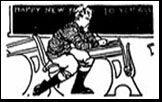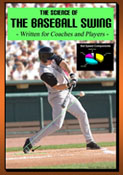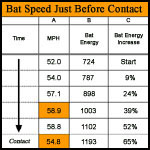- The Coach's Corner-
Test Yourself on theTerminology & Composition of the Swing
to
Maximize Your Knowledge
 Here are 14 questions for you to test yourself on the "terminology" of the swing.
Here are 14 questions for you to test yourself on the "terminology" of the swing.
As coaches you are the experts in teaching the swing. We are technical folks who simply stared at the math, and were simultaneously confused by the many misleading terms used to describe the baseball swing. One of our missions was to clarify these terms, and what the "why" is behind them.
Understanding the terminology is 50% of the learning battle for any subject. Once you understand the terminology, then you are suddenly an expert in that field. Mission accomplished. We conquered all the terms.
These 14 questions are now your chance to ask yourself these same, mostly terminology, questions and thus determine how much of an expert you really are regarding the intrinsics of the baseball swing.
For your convenience, we've answered these 14 questions, as well as another 10 or more, in the attached Coach's Quiz.
You can think of these questions as a coach-oriented exam on the intrinsics of the swing - - stuff that is relevant to you as a hitting coach working with players. No calculator required!
We went a step further and used our model to get mathematical answers to these questions. This provides the other 50% of the learning battle and provides tremendous confidence in the resulting knowledge. Thus you'll be a better expert once we share these insights.
Whereas "Field Guide - Power Summary" is a summary section for actual ballplayers, this Coach's Quiz is the summary section for coaches. These condense the entire Manuscript down to bottom-line information for use on the field and in the gym.

1- The Weight Shift (The Stride) - What does it really accomplish?
This is the first commitment you do in your swing. It takes advantage of gravity. You lift your front leg; you lift the bat; you lift your arms; you lift your entire body. You are now in what is often referred to as the “trigger” or "coiled" position. After this your body moves forward and down. It drops! We call this the “free-fall”. It is sometimes referred to as the weight shift maneuver, the stride, the step, etc. The question is what does this “free-fall” really accomplish? Why not simply stand still and swing without falling? (Hint: The answer has nothing to do with motion.)
2- Name 3 reasons why you "Keep your hands inside the ball".
We call this “bringing the knob of the bat to the baseball”. Others call it “keeping your hands inside the ball”. This keeps the bat-head close to you during the initial part of your swing. (See the picture at the left under "Maximize your Power"). Thus the question is why do you want the bat-head close to you - - and pointing backwards - - during the initial part of your swing?
3- What happens after you "Keep your hands inside the ball"?
When you “keep your hands inside the ball”, the bat-head is pointing behind you. After that you obviously want to bring the bat-head (the sweet spot) to the baseball. The question is what do you actually do in order to bring the sweet spot to the baseball?
4- The Ice Skater Effect - What is its impact on your Power?
When an ice skater sticks out his/her arms, they slow down. When you extend your arms during your swing, you tend to slow down as well. Does this have a minor impact or a major impact on your power? Is it worth hugging the plate and risk getting hit to reduce this effect on your power?
5- Mystery of Extension - What's the net effect?
This is similar to the ice skater question above. If the ice skater effect slows down your torso rotational speed, then is there any corresponding benefit to extension? Do you want to extend a lot or a little?
6- Rotational Momentum- What is it and what is it for?
When you initially rotate your torso, this is sometimes referred to “storing” rotational momentum or “storing” energy. This question is “do you understand what this means”?
7- What exactly is "capturing" rotational momentum?
Baseball is full of misleading terms. After you “store” rotational momentum (covered above), you then “capture” that rotational momentum. These two terms go together. The question is do you understand what these terms mean? If yes, then what do you do as a batter to both “store”, and then “capture”.
8- The Last 1/3 of your Swing - What's really going on?
In the last 1/3 of your swing, if you look at videos you see that most of the bat speed appears to be generated there. The question is why? What are you doing as a batter that creates this rapid increase?
9- Which bone is your single dominant Aiming Tool?
This is a real question with a single bone answer.
10- Why are high fastballs such a dominant strikeout tool?
Pitchers have plenty of strikeout tools. Sneaking in a high fastball is one of them. One reason, of course, is batters like hitting them. It's like a fish loving worms - - The ball goes far if you make contact. What this question is really asking you is if you are expecting a pitch in one area, and it is instead in another area of the plate, how much can you really adjust your aim up/down in the little bit of time that you have? How do you get around this (physics) issue?
11- What does Push/Pull Actually accomplish?
More misleading terms. Some schools teach you to push with one hand and pull with another, in the effort to bring the sweet spot to the baseball. This is during the last 1/2 or last 1/3 of your swing. The question is what does “push/pull” really mean? What does it accomplish?
12- What’s your Power V really for?
The Power V is formed by your arms as the bat approaches contact position. In Japan it is called your Pyramid. The question is why do these reference the actual geometrical shape, and what is the significance of that shape?
13- Front Leg Snap - What is it really doing?
It’s obvious that your rear foot push-off rotates your torso. What does the front leg snap accomplish?
14- What is "Getting All of It" really about?
To announcers, this means that the ball really went far. That doesn’t explain anything. What does “Getting All of IT” really mean? What is the “It”? What is the “Getting”? How much do you really “Get”?
All of these questions, and more (25 or more total) are answered in the Coach's Quiz. We provide quantitative answers as well as the qualitative answer.






SUPPLEMENTS - Thumbnail.jpg)